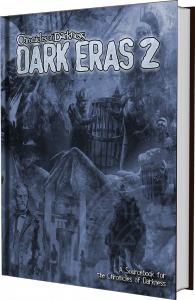This piece was sent out for last month’s update to Dark Eras 2 backers, and we thought we’d share it with our lovely blog readers:
Matthew here, to address the pressing subject of redlines. We’re receiving the first drafts for Dark Eras 2, and will be entering this joyous stage once we have all of them.
No phrase is more feared among the pool of freelancing writers than “I have redlined your work, and..” And what? Is my work clean? Does it need rewriting from scratch? Oh Lord, it’s going to be awful, isn’t it? I’ll never write again.
Calm thy jets, friend writer. Redlining is not a punishment process, and should not be used to belittle, mock, or humiliate writers. Redlines are ideally used as an instructional tool. Good redlines are what keep a draft on topic, highlight the best bits, underscore the parts in need of improvement, and importantly, comment on how to improve this and future work to ensure errors do not repeat between drafts.
Here’s a list of the kind of things Monica, Meghan, and I will be doing as part of the redlining process for chapters for this book, and the order in which I approach this task as developer:
- Read the draft in full without leaving comments or making amendments.
- Review. Does the draft sit consistently within the game line/s it’s set up to serve? (i.e. does the Scandinavian Witch Trials era cover the era, player options, Storyteller options, Geist, and Mummy?)
- If yes, continue to point 5.
- If no, read through the draft again, highlighting instances where tone, language, or game terms are incorrect and require amendment or rewriting.
- Read through the draft again, correcting common mistakes usually involving passive voice, adverbs, British English seeping into an American English draft, etc. This part is very important as this is where a writer learns not to make these mistakes in future drafts. Do not correct every mistake of this kind. Correct several, and then leave a comment for the writer to correct the rest.
- Read through any mechanical / system sections of the draft and ensure the stats are correct. If wildly incorrect, leave a comment for the writer to touch base with you prior to starting final drafts so we can go through any misunderstandings of what the differences are between Affinities and Utterances (to use the Mummy example).
- Ensure comments are left to compliment the strengths of the draft. Nobody likes to be told their work requires nothing but correction.
- Leave notes at the top or bottom of the draft summarizing the redlines and what big changes are necessary, along with other writers they might need to contact to ensure drafts gel (especially on this book, where writers are sharing chapters).
- One more read through to ensure you caught everything.
- Send the draft back to the writer for final drafts stage. The common notes that I leave concern outrageously excessive uses of adverbs and frequent appearances of the word “that.” Seriously, construct an interesting paragraph or two about your job that you could use to train new employees, so that they could step in and do it for you in your absence. Now re-read the above paragraph and remove almost all adverbs and uses of the word “that.” It’ll read a lot better.
Anyhow, redlining is a necessary phase and something we must do to ensure a draft reads well, has the right direction for the book, and teaches writers on where they need to improve in future. Speaking from personal experience, my writing has improved considerably based on redlines I received from developers such as Stew Wilson, Richard Dansky, and Danielle Lauzon, to name a few of the individuals who led projects on which I was a writer.
Now we need to get to it! See you next time!
Chronicles of Darkness: Dark Eras 2 is available for pre-order on BackerKit.


As a fellow writer and RPG contributor I love reading things like this!